|
|
 |
 
|
|
f i l m p a c k
|
Film Packs
Film Packs were introduced in 1903. Initially known as the Premo Film Pack, after 1922 they were renamed as the Kodak Film Pack, and were available in a range of sizes from 6x4.5cm to 13x18cm (5x7"). Possibly originally designed as a replacement for glass plates, indeed adaptors were available for many cameras, until the mid-1920's Eastman Kodak manufactured many cameras with the Premo and Hawk-Eye brand names specifically for this format.
An interesting cross-over between old and new technology, the Film Pack comprised 12 cut celluloid films, stored in an (initially cardboard, later metal) outer that was simply placed in the back of the camera, packed in such a way that the simple expedient of pulling a paper tab loaded a fresh film into place for each exposure, the previously exposed film being at the same time moved to the back of the pack. Each of the paper tabs, which protrude through a slot in the camera and were torn off after being used, had a number on it which acted as a basic, though perfectly efficient, exposure counter.
Shown here are two views of a Premoette Junior No.1, with and without a Film Pack loaded.


One advantage of this system was that at any time the Film Pack could be removed from the camera (in a darkroom) and the exposed films removed for processing, individually if required, thus giving much of the flexibility of glass plates or cut film in dark slides, without the bulk and weight of these formats. The remaining unexposed films, still in the pack, could then be re-fitted into the camera for future use. It was several decades, until the introduction of the Instamatic in 1963, before film loading was again so easy for the general public.

Film Packs would have probably been available loaded with most of the emulsions of the day. I have one pack of size 520 (2¼x3¼" or 6x9cm) 'Kodak Super-XX', shown above, which was an ultra high-speed film of it's time, with an approximate "modern" rating of 200ASA.
|
 
|
|

